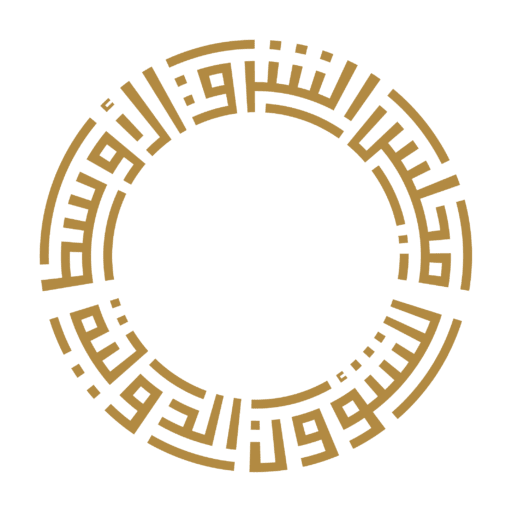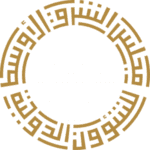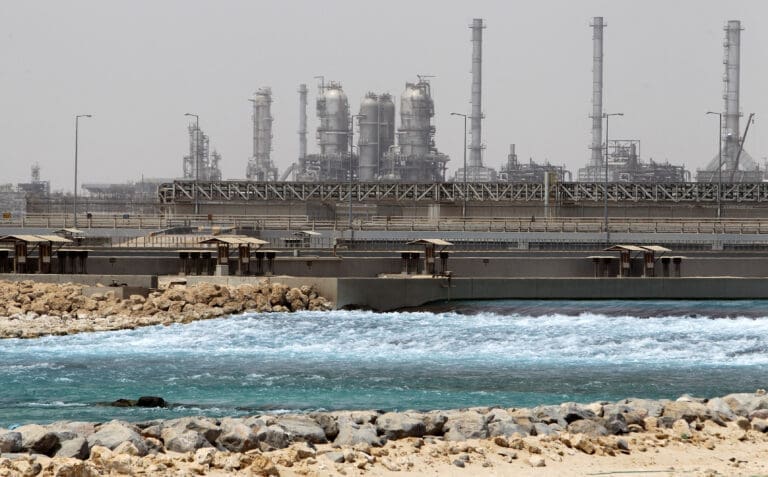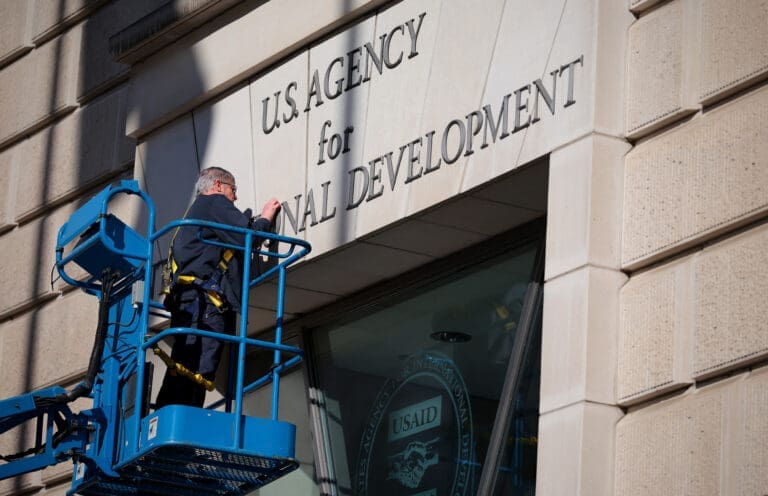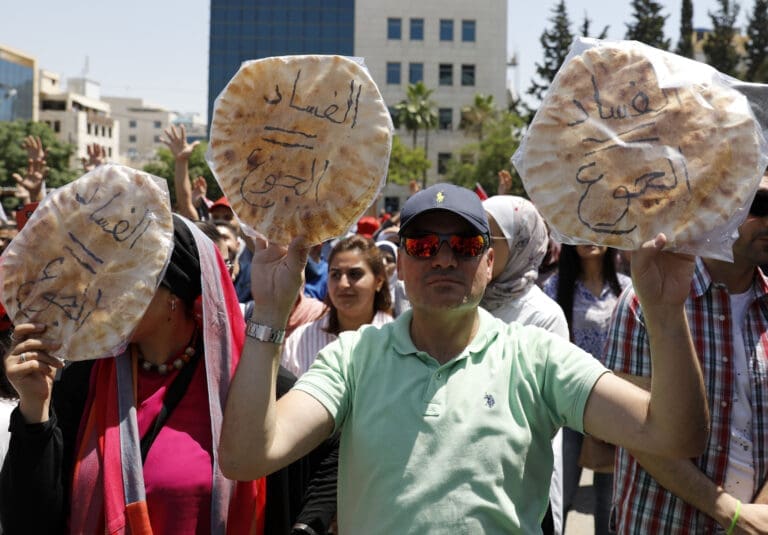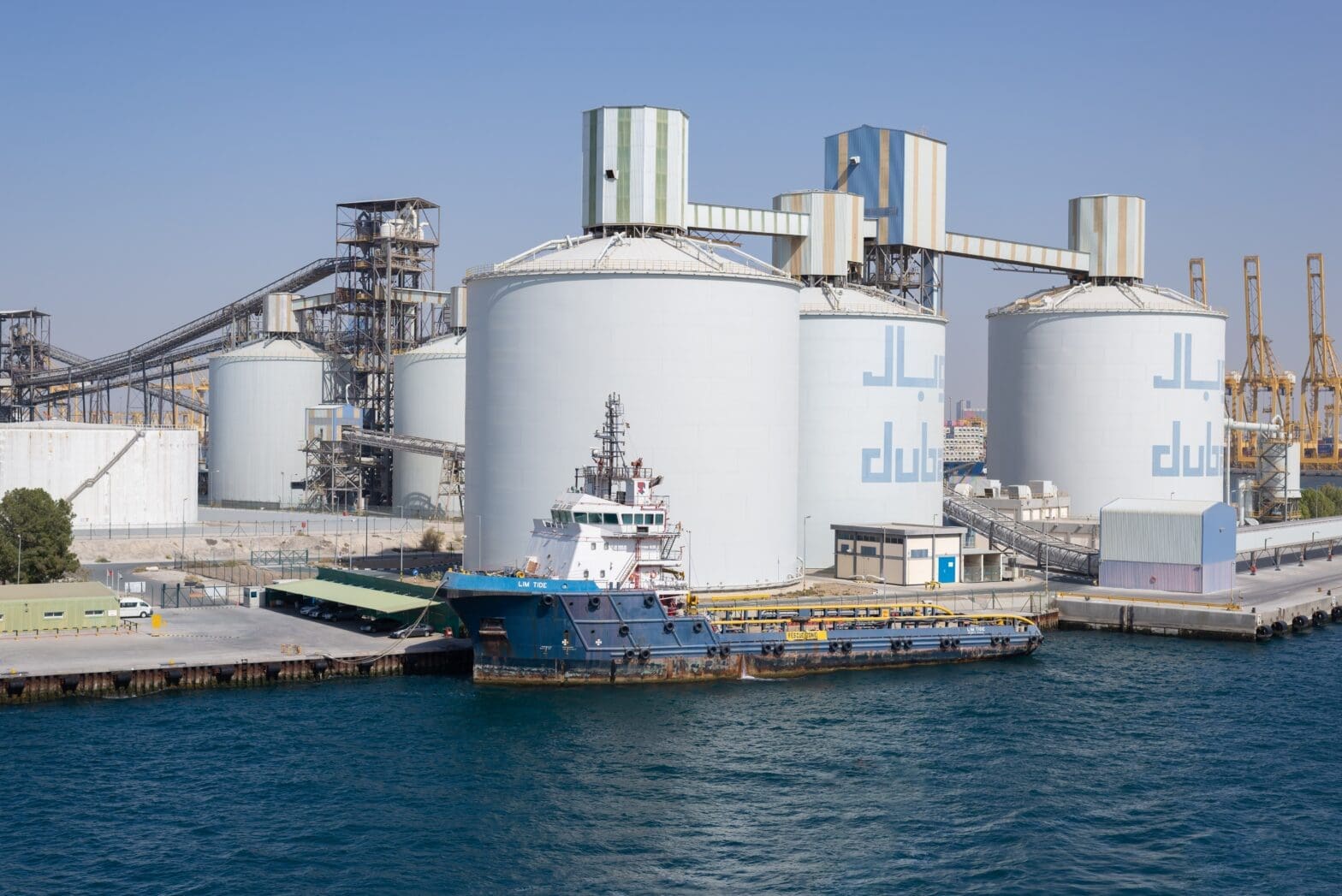
Gulf Industrial Policy in a Changing Global Economy
Policy Paper, October 2025
Abstract
Industrial policy, which is the proactive effort by governments to support strategic industries, is experiencing a global resurgence after years of neglect. However, even when interest waned globally, industrial policy had continued to play a key role among Gulf Cooperation Council (GCC) governments. It has provided Gulf states with an effective basis for securing economic development and diversification goals, helping to mitigate the rentier nature of their oil- and gas-dominated economies, address disincentives within the private sector for investment in export-oriented manufacturing, and facilitate the redistribution of centralized oil and gas revenues. Gulf states are now leveraging industrial policy to pursue more dynamic efforts at economic growth and expansion, particularly into high-technology areas where low-cost energy inputs and public investment will be key enablers. Yet, industrial policy in the Gulf is prone to vulnerabilities including state capture, the politicization of economic decisionmaking, and the growing uncertainty associated with recent changes in the global economy. Building resiliency in the face of these risks while delivering sustainable growth will require Gulf policymakers to become increasingly sophisticated in selecting the sectors and tools for their engagement and more proactive in insulating decision-making on industrial investments from non-economic considerations.
Key Recommendations
- Support Sectors, not Companies: To maximize its impact, Gulf industrial policy should support multiple sectors through education, infrastructure, and improvements to the broader business environment, rather than direct government support for specific companies and initiatives.
- Use Rules-based Investment Targets: GCC governments should set performance targets for fully or majority state-owned firms, maintaining the perspective of venture capitalists rather than indefinitely sustaining loss-making, nonperforming firms.
- Develop a more Robust Conceptual and Operational Distinction between the Public and Private spheres: The Gulf states should encourage private sector participation in diversification through partnerships and policy incentives. A complementary measure would include strengthening competition policy.
- Reinvigorate Regional Cooperation and Coordination: Gulf governments should enhance the alignment between industrial policy and regional investments in transit and logistics, which would allow them to avoid redundant and overlapping investment and facilitate constructive competition.
Introduction
In the 1980s, global economic policy shifted away from government intervention, focusing instead on free trade and market-driven development. This has allowed countries to secure unprecedented gains in development and poverty alleviation, building on their areas of comparative advantage as firms have found strategic niches in international supply chains. In recent years, many countries have returned to industrial policy—which involves the use of instruments like tax incentives, subsidies, tariffs, government procurement, grants and direct public investment—to bolster certain sectors in the service of broader economic and social objectives. Several factors have driven this return to more proactive government intervention, including the supply constraints that arose during the COVID-19 pandemic, climate change and the transition to greener economies, security concerns, and growing pressures towards protectionism in many OECD countries.
While the Gulf states have prioritized private sector development over the past two decades, these governments never abandoned industrial policy.1 Some degree of central planning, based on five-year national development plans and industrial development strategies, has provided an anchor for Gulf development efforts since at least the 1960s, allowing these governments to redistribute revenues from oil and gas exports in ways that support economic diversification, rapid infrastructure development, and public welfare. Each of these countries is now pushing forward with more ambitious strategies. Their national vision documents for 2020-2030 have introduced expanded national industrialization and manufacturing goals, identifying a wide range of sectors for government support and mapping out more detailed pathways for advancement.
The Gulf states now face risks to these efforts. Some are inherent in any government intervention in the economy. Others reflect the unique challenges of diversification in resource-rich economies, pressures to reduce humanity’s global carbon footprint, or the tectonic shifts underway in the international economic order. Yet there are also opportunities to leverage oil wealth in creative ways to address chronic vulnerabilities and invest in future-facing sectors.
This paper reflects upon how Gulf states can pursue effective industrial policies in the context of significant turmoil and uncertainty. It reviews the history of industrial policy in the Gulf to date, describes recent sectoral priorities, and identifies risks and vulnerabilities. The paper then suggests ways for policymakers to limit potential downsides and maximize gains from their future industrial policies.
The History of Industrial Policy in the Gulf
The export of petroleum products and derivatives has rapidly transformed this once poor region while creating a dependence on oil and gas production that has proven difficult to escape. This reflects the rentier nature of the oil economy and so-called “Dutch Disease,” further reinforced by the centralized nature of national oil companies’ revenues.2 Together, these factors have incentivized private investors to focus on importing manufactured goods, construction, real estate, and service provision, instead of taking the greater risks associated with export-oriented manufacturing and industrialization.
Gulf leaders have long acknowledged the need to diversify their economies to enable sustainable growth, create higher quality jobs for a growing national labor supply, and allow states to hedge against the volatility of the international oil market. They have anchored their ambitions in five-year economic plans and the creation of state-owned enterprises (SOEs) or government investment to expand domestic manufacturing and industrialization, while driving growth in globally linked services like tourism and logistics.
Bahrain was the first Gulf state to launch a five-year development plan, including an industrialization and diversification strategy.3 This plan, launched in 1968, focused on creating an alternative to oil for a country already aware of its declining reserves. That same year, the government launched Aluminium Bahrain, a joint venture between the government and several international partners. In 1977, Bahrain launched its Arab Shipbuilding and Repair Yard with major shareholdings by all Arab Gulf governments.4 These early majority state-owned enterprises created a capacity for the industrial inputs and exportable services needed by the broader Gulf economy while creating jobs for Bahraini nationals.
Dubai and the northern emirates also focused on government-backed industrialization. In 1970, Dubai began building Port Rashid and the World Trade Center, the first steps toward establishing itself as an international trade and investment hub. It also established Dubai Aluminum in 1979. Neighboring Ras Al-Khaimah established RAK Ceramics, while Sharjah built a seaport and invested in paint manufacturing. Oman sought to stimulate slower growth and develop value chains in traditional trades like agriculture and fisheries, while expanding its oil industry and investing in trade infrastructure.5 Each was able to incentivize broader industrial capacity through public investment in industrial zones and supportive government procurement regulations.
Early industrial policy in oil-rich Abu Dhabi, Kuwait, Saudi Arabia, and Qatar focused more on adding value into the petroleum industry, taking advantage of low-cost feedstocks to build a comparative advantage in the production of refined fuels, petrochemicals and plastics. Saudi Arabia launched the Saudi Arabia Basic Industries Corporation (SABIC) in 1976 to lead industrial development in energy-intensive manufacturing, fertilizer and petrochemicals.6 The Abu Dhabi National Oil Company (ADNOC) expanded downstream production of fertilizers and refined products.7 Kuwait and Qatar followed similar approaches, leveraging public investment to establish basic industries like cement, steel and food production. However, such efforts remained dependent on government investment. As international oil prices and government budgets declined in the mid-1980s, public investment in manufacturing and industrialization became less aggressive and (in some cases) stagnated.
In the 1980s and 1990s, Bahrain and Dubai relied on the government playing a leading role in the economy. Bahrain focused on the financial sector, seeking to replace Beirut as the regional finance and banking hub and to become an early innovator in Islamic finance.8 Dubai focused on trade, logistics, and commercial development.9 In 1985, it established the Jebel Ali Free Trade Zone (JAFZA), offering domestic and international investors a unique resource for manufacturing and trade. Drawing inspiration from Singapore and Hong Kong, JAFZA filled an important logistical gap in global trade networks. Dubai began expanding the free trade zone approach to develop industry-specific hubs like the Dubai International Financial Center and Healthcare City.
In both states, support from public and quasi-public investment companies provided an important resource for development. However, they depended heavily on attracting domestic and foreign private investment through conditional land transfers, long-term land leases, limiting regulation, and eliminating or easing domestic ownership requirements. Each government also established new public entities (Bahrain’s Economic Development Board and Dubai’s Executive Office) to oversee policy implementation.
During this period, Gulf states—struggling with lower oil revenues—also refocused their industrial policies to stimulate private domestic investment and attract foreign direct investment (FDI). They sought to expand industry-specific ecosystems (particularly in petrochemicals) and listed large SOEs on local and international stock markets. Significant funding was also earmarked for grants and startup incentives for small and medium enterprises (SMEs). Governments took steps to ease business regulations and procedures.10 They also moved to support local firms and private sector hiring of nationals through input subsidies and government procurement.11
Gulf Industrial Policy Today
Contemporary Gulf industrial policy covers a broader range of industries—with more careful planning around how to deploy complementary approaches—and considers how to build on existing strengths to ensure that investments in nascent industries are successful. These policies can be loosely placed in three categories: (1) traditional strategic sectors and priorities; (2) potential growth sectors; and (3) more risky and ambitious ventures.
The first includes areas of core comparative advantage in many Gulf countries (energy and petroleum derivatives), as well as those traditionally pursued by other countries (defense and food security) and motivated by geopolitical and strategic considerations in addition to economic ones. The second bundle includes areas of potential comparative advantage, such as healthcare, transport and logistics. By combining astute policies and effective implementation, some GCC states could compete successfully on the global stage in these sectors—particularly those with a “first mover” advantage. Others will not. The final category, which includes technology, is more speculative. Although several GCC countries are aggressively investing in artificial intelligence (AI), chip manufacturing and large data processing centers, success is far from guaranteed.
The following is a brief discussion of the GCC’s evolving industrial policy tools.
1-Traditional Strategic Sectors and Priorities:
Energy: The energy sector remains a central feature of Gulf industrial policy—not only as an engine for revenue but as a launchpad for macroeconomic diversification. While hydrocarbons continue to dominate their economies, Saudi Arabia, the UAE, and Qatar are moving aggressively to generate increased wealth from downstream ventures, advanced industrial manufacturing, and other derivative industries.
This builds on a two-pronged approach. First, they seek to monetize hydrocarbons beyond unprocessed exports, such as crude oil and LNG, to stimulate growth in petrochemical and specialty chemical clusters. Second, they are leveraging national champions such as Aramco, ADNOC, and Qatar Energy (QE) as linchpins for broader industrial growth. These state-owned energy companies are repositioning themselves as integrated industrial conglomerates—expanding internationally, modernizing operations, launching IPOs, and forming strategic joint ventures with global firms. Petrochemical expansion remains key, as in SABIC’s advanced polymers strategy or ADNOC’s Ruwais industrial hub. Yet this approach carries significant risk. A looming global petrochemicals glut, as well as environmental and health concerns with plastic production, may undermine long-term returns.
Alongside hydrocarbons, GCC states are scaling up renewable and alternative energy platforms. Masdar and ACWA Power are leading solar and wind deployments across the region and beyond. Nuclear facilities such as the UAE’s Barakah plant contribute to the country’s domestic decarbonization and energy security goals. Saudi Arabia is also pursuing nuclear development, though its program has encountered substantial delays and geopolitical headwinds. These developments telegraph a long-term pivot toward redefining the region, from a supplier of raw energy resources to a value-added energy hub, able to deliver cleaner, diversified, strategic commodities for global markets. The ultimate goal for Gulf policymakers is to maintain energy dominance while building a credible foundation for climate-aligned competitiveness in a “post-oil” world.
Defense: The security sector features prominently in the industrial policies of many countries, including those of the Gulf states. However, Saudi Arabia and the UAE are the only GCC countries that are aggressively embracing this sector for export. Both have a history of using “offset” arrangements, which typically involve foreign defense contractors working with local suppliers to facilitate technology transfer, local employment or co-production.
In the UAE, the Tawazun Economic Council was tasked in 2021 with overseeing procurement for the UAE Armed Forces and Abu Dhabi police, with the goal of developing the defense sector, producing high-value exports, and generating jobs for Emirati nationals.[i] Priorities include aerospace, ammunition and weapons, autonomous systems, advanced metals and materials, and command-and-control systems, among others. Uniquely in the Middle East and North Africa, the UAE is also active in space exploration.13 In collaboration with Japan and the United States, it launched the Hope Probe to Mars in 2020, and it is currently developing the Rashid Rover for exploring the lunar surface.
Similarly, Saudi Arabia plans to maximize its current offset programs to develop a world-class defense industry.14 It established the General Authority for Military Industries (GAMI) in 2017 to oversee collaboration with global defense manufacturers to produce goods domestically for the Kingdom’s military, as well as for export to global markets. Saudi Arabia’s Public Investment Fund (PIF) created Saudi Arabian Military Industries (SAMI), a wholly owned local subsidiary, in 2017 to oversee military production. The Kingdom expanded local production of military equipment from 2% in 2016 to 8% in 2020.15 Key priorities include aeronautics, weapons, defense electronics, and emerging technology. SAMI aspires to become one of the top 25 global defense companies by 2030.
Food Security: While GCC countries are not food insecure in the classic sense of the term, they face serious risks due to their low domestic productive capability and heavy reliance upon food imports. GCC countries import about 85% of their food, including around 93% of cereals; 62% of meat; and 56% of vegetables.16 In response, they are adopting a variety of strategies to protect their populations. Most are focused on improving domestic agricultural production and expanding productivity, using genetically modified crops, precision agriculture, hydroponics and other cutting-edge techniques to increase yields. They are also investing heavily in infrastructure, particularly storage facilities, and in better information systems to improve supply chain efficiency. They are developing their food and water security capabilities—although water remains a constraint—and looking to diversify their global supply chains and streamline their import procedures to alleviate bottlenecks.
Gulf countries are using public-private partnerships (PPPs) to support many of these initiatives. With financing from the PIF, Saudi Arabia is looking to source 85% of its food processing from 11 domestic clusters by 2030.17 These clusters will cater to manufacturers, service providers, logistics services, and laboratories by providing ready-built facilities in a public-private partnership supported by the Saudi Industrial Property Authority (Modon).18 In the UAE, Food Tech Valley is a technology hub designed to foster clean, tech-based food and agricultural products as part of an effort to triple the country’s food production.19 Oman plans to build a $4.2 billion agricultural city that will leverage advanced technologies such as hydroponics, aeroponics and fish farming to reduce dependence upon food imports.20
2-Potential Growth Sectors:
Healthcare and Medical Tourism: Healthcare is one of the few areas that every Gulf country has pledged to develop. All have affirmed their intent to make high-quality healthcare available to their citizens. Qatar, Saudi Arabia and the UAE have gone further and embraced medical tourism as a potential growth area, seeking to become global destinations for specialized medical care. This is seen as essential to building resilience and attracting leading experts in fields such as AI-driven precision medicine (the UAE) and genome sciences (Qatar). Saudi Arabia is expecting its share of the medical tourism market to more than triple between 2024-2030, to $680 million.21 The Kingdom is focusing on providing specialized care in areas including cardiology, orthopedics, organ transplants and cancer treatments. Accordingly, Riyadh is investing heavily in infrastructure, including hospitals and digital technologies, streamlining visa application procedures, actively promoting the Kingdom as a destination for medical tourism, and fostering partnerships with private healthcare providers.22
Transport and Logistics: Building on past investments in national airlines, transport infrastructure, and free trade zones, GCC governments are leaders in the development of trade and logistics capacity. This is largely driven by the region’s geographic location, the global importance of its energy resources, and efforts to expand its relevance amid dramatic changes to the global economy. Expanding its capacity in trade logistics allows the Gulf to play a central role in bypassing security bottlenecks like the Red Sea and Suez Canal, linking nascent industrial supply chains between Europe, South Asia, and East Asia, along with emerging regional manufacturing hubs like Türkiye.
3-More Risky and Ambitious Ventures:
Technology: Gulf states are seeking to seize strategic positions in high-tech manufacturing and service delivery, including information technology, data warehousing, AI, chip manufacturing, and applications in financial technology (fintech), agricultural technology, and biotech. Initial announcements have been met with skepticism, as the Gulf currently lacks a comparative advantage in these areas, particularly in terms of available skillsets or the presence of major research universities. However, Gulf governments can bring large amounts of risk-tolerant capital to potential partners while sitting in a strategically important position between the U.S. and China, whose mutual security concerns are impeding investment and causing firms and governments to seek creative solutions to ensure the expansion of the global tech industry. Perhaps most importantly, Gulf states offer international tech firms access to cheap energy for increasingly energy-intensive technologies. Here, government plays an essential role not only in providing capital and energy inputs, but in managing strategic relationships with multinational corporations.
Changing Dynamics of Industrial Policy in the Gulf
In recent years, Gulf states have expanded the approaches and instruments they have deployed in their pursuit of growth and diversification. While Gulf industrial policy has traditionally been centered on SOEs, they have increasingly involved domestic and foreign investors in specific projects while maintaining a large role for government entities as core investors. Government financial entities and sovereign wealth funds are investing in foreign companies and industries, providing Gulf governments with diversified investment streams while facilitating technology transfer. Seeking to expand industry-specific ecosystems and manufacturing hubs, governments are playing a lead role in the broader development of these hubs while attracting private investment through incentives like land transfers, business-friendly regulations, fee reduction, and access to finance. Local stock exchanges also allow Gulf governments to secure broader ownership of firms, while expanding capital available for industrial growth and diversification.
Risks and Vulnerabilities in Gulf Industrial Policy
While Gulf governments have expanded the modes of their approach to industrial policy, they face a complex set of risks and vulnerabilities in its application. The broadest and most basic issue is whether Gulf policymakers are better positioned to identify and build successful industries than private investors and entrepreneurs. Economists have long argued that the efficiency of the market optimizes growth and resource allocation. Government policymakers are at risk of making poor decisions, constrained by limited market information and burdened with the obligation to meet social and political goals in addition to economic ones.
Gulf states also face several inter-related domestic concerns that are dictated by the nature of their rentier economies. They are under considerable pressure to provide citizens with employment guarantees and protections, as well as to protect local investors from risk. Both pressures lead to moral hazard risks—the incentivization of financial recklessness—as Gulf leaders often maintain nonperforming investments and bail out private investors who have made poor investment decisions. While production costs are low, Gulf governments subsidize energy heavily, particularly in sectors prioritized under industrial policy goals. The volatility of petroleum prices has historically led to large fluctuations in government investment for industrialization. Support for industrial policy initiatives rises with high oil prices and declines rapidly as revenues fall, leading to costly project delays or cancellations.
A final hurdle is the continued dependence of most GCC economies on oil exports. The focus on a single export sector, generating rents far in excess of what could realistically be attained through manufacturing. In 2024, for example, oil and natural gas sales generated an average per capita GDP of $28,595 in Qatar. By comparison, in Germany, which has one of the largest manufacturing sectors as a proportion of GDP in the world, that sector generated a per capita GDP of around $12,165.23 For most GCC countries, manufacturing is never likely to replace the revenues that they are now receiving from hydrocarbon exports.
External Risks and Uncertainties
Externally, the world in which Gulf countries have historically framed their industrial policies is changing rapidly, whether one looks at this through a geopolitical lens, an economic lens, or a climate lens. These shifts may require a flexibility, adroitness and responsiveness that traditional approaches to industrial policy often lack.
Worries about climate change and net-zero emissions targets are likely to lead to a global reduction in demand for hydrocarbon products over time, placing additional pressure on the long-standing (and only moderately successful) efforts in many GCC countries to attain greater diversification. As noted above, Gulf countries face a particularly difficult task of trying to maximize their current revenues from oil and natural gas while transitioning to a low-carbon economy. Whether their efforts to move towards higher value-added products with lower carbon footprints will ultimately be successful remains an open question.
The second global headwind is the mounting uncertainty surrounding the international economic environment. The movement towards unrestricted free trade appears to be coming to an end, buffeted by the surge in populism and protectionism in the United States and other countries. The ultimate shape of the emerging world economic order remains to be defined, but the export-led manufacturing that was essential to East Asia’s rapid growth is unlikely to be a viable path for GCC countries. That space is currently shrinking and is already quite competitive.
Tariff barriers and protectionism aside, GCC countries face a host of structural economic constraints. Their relatively expensive labor markets and high reservation wages—the lowest rate at which an individual will accept a job—are not competitive for low-wage manufacturing, and labor productivity has grown slowly.24 The lack of skills in science, technology, engineering and mathematics undermines their push for tech-centric innovation and growth. With the possible exception of Saudi Arabia, small domestic markets and local ownership requirements make GCC countries relatively unattractive as investment destinations for many international companies. Countries such as Qatar and the UAE have moved adroitly to take advantage of the region’s location at the nexus of Europe, Asia and Africa to become transport and logistics centers or regional hubs for finance and consulting. But as they have claimed first-mover advantage, others may struggle to duplicate their success.
More uncertainty arises from the role of regional organizations, such as the Gulf Cooperation Council (GCC), and trade corridors, such as the proposed India-Middle East-Europe Economic Corridor (IMEC) or the Iraq Development Road Project championed by Türkiye. How will these competing visions impact industrial policy decisions among Gulf countries? Greater regional integration within the GCC would be the most natural alternative to retreating from the global free trade regime. The GCC has supported greater integration in national industrial policies since at least 2000, when it published its call for a Unified Industrial Development Strategy.25 It established the Gulf Organization for Industrial Consulting (GOIC) to foster industrial collaboration as early as 1976. Recently, the GOIC has sought to establish a Gulf Industrial Projects Platform, which aims to enhance industrial integration among GCC countries by facilitating data exchange through a dedicated online platform for Gulf industrial projects.26
Yet the GCC remains an imperfect forum for coordination and cannot impose obligations on its member states. Trust between members was seriously degraded during the 2017-2021 blockade of Qatar and will take time to fully restore.27 Deeper issues remain, including the five smaller members’ concerns about Saudi dominance; the similar structure of their economies, which limits the potential gains from trade and integration within the bloc; and the personalization of decision-making within Gulf monarchies, who have been reluctant to cede authority to multilateral institutions.28 The GCC has achieved some success, such as the creation of a customs union in 2003 and a common market in 2008, and some accomplishments in integrating economic and industrial regulations. Yet several broader attempts at integration, such as the currency union proposed in 2009, have failed. Efforts to implement a unified value-added tax (VAT), originally agreed on in 2016, drag on.29
With enough political will, these challenges could be overcome. Greater integration is possible, particularly in selected sectors (such as the pan-Gulf power grid or joint hydrocarbon production projects) or at the sub-region level (such as the Oman-UAE rail link). Yet the history of the GCC to date gives little hope for more than modest, incremental progress over time. The challenges are even more pronounced regarding proposed regional corridors such as IMEC or the Iraq Development Road Project, both of which remain in the formative stages.30
Building Resilience into Gulf Industrial Policy
Confronted by such challenges, many GCC countries could be forgiven for adopting a “stay-the-course” approach to their current industrial policies, for several reasons. There are too many external unknowns to model and plan for. Is the current rush towards tariffs and protectionism a passing fad or a new and enduring feature of the global economic order? Will India or Türkiye’s vision of a new transport corridor prevail? How will green technologies ultimately shape the trajectory of hydrocarbon markets? Will consumers 20 years from now embrace the transition towards petroleum products with a lower carbon footprint or view it as insufficient? Given the long lead times and planning cycles in the crafting of national vision documents and development plans, and the considerable investment of political, human and financial capital in their creation, it may be better to let developments play out—perhaps with modest tweaks—than to pursue a wholescale reorientation, particularly when the ultimate direction remains unclear.
Mistakes have been made and billions squandered on mega-projects such as the King Abduallah Financial District. Millions more have been paid to consulting firms for advice and analysis that was ultimately unhelpful. Yet whether by design or default, Gulf countries have managed to get a lot of things right. Investments in improving the overall business environment, building world-class infrastructure, or forging partnerships in higher education to create a skilled national workforce are consistent with the latest thinking about how industrial policy should be conducted.
Meanwhile, there are several other measures that the Gulf states could adopt to bolster the effectiveness of their industrial policy strategies:
Firstly, as Dani Rodrik and others have argued, industrial policy interventions should be targeted at activities, not sectors, making them fungible across industries and generate positive spillover effects.31 Such approaches also minimize the risks from losing bets on a single company or industry. While the unique economic circumstances of rentier states creates their own set of challenges, the GCC should stay the course on such broad cross-cutting reforms and investments, which will pay dividends under most scenarios.
Second, Gulf countries should develop a more robust conceptual and operational distinction between the public and private spheres. As we noted above, state involvement in sectors such as energy, defense and food security is clearly justified. Other sectors are borderline calls, while some are highly risky. Yet state involvement can often stretch well beyond these limits. Many within the GCC are comfortable with state capitalism, and the lines between public and private interventions are often much more blurry than those typically found in OECD countries. A more rigorous delineation of the boundaries for state involvement would prevent Gulf governments from inadvertently crowding out private investment.
Third, a complementary move in this regard would be a push toward developing and implementing a robust competition policy. The Arab region in general has a strong dirigiste tradition, and competition laws are a relatively new phenomenon. Recently, there has been an effort to improve competition legislation in many GCC countries, with Kuwait, Oman, Saudi Arabia and the UAE all enacting or beefing up their competition legislation since 2020.32 One recent independent assessment noted: “On balance, the evolution of competition regimes in the Middle East reflects a growing alignment with global standards over the past six years… driven by increased economic activity and an interest, particularly by the GCC countries, to attract foreign investment.”33 While this trend is welcome, developing and implementing robust competition policies will remain a major challenge throughout the region. A few countries, such as Saudi Arabia, have made significant progress.34 But other GCC countries (such as Bahrain, Oman and Qatar) have been evaluated as providing “only basic enforcement.”35
Fourth, Gulf states should take steps to counter the cyclicality of oil volatility and its impact upon investment flows. This would help ensure that expenditure on industrial development will be consistent, avoiding the interruptions seen during previous oil price downturns. Reserves and sovereign wealth funds, as well as government borrowing, can be leveraged to eliminate this volatility, funding planned investments as budgetary pressures emerge. Ensuring that these funds follow specific rule-based spending targets is essential.
Fifth, Gulf governments need to set and adhere to specific targets when it comes to assessing the viability of investments where they are the dominant shareholder—particularly when dealing with risky sectors such as information technology (IT). As owners, governments are prone to maintain control over poorly performing firms to protect employees and avoid acknowledging the sunk costs associated with these investments. As the consulting firm Strategy& notes, governments investing in industrialization and diversification should maintain a perspective aligned with that of venture capitalists, willing to accept the risks of entrepreneurial ventures but also ready to close, sell off, or break up nonperforming firms.36 The aggressive use of competition policy should ensure that they are subject to market discipline early in their development.
Sixth, while there is a role for Gulf governments as lead investors, industrial policy outcomes will be more sustainable and stimulate more diversified growth when balanced with efforts to encourage private sector partnerships and to bring in private investors early on. Rather than crowding out private investment, Gulf industrial policy should bring in the private sector, coordinating investments with private investors and stimulating demand through government expenditure and investment priorities.
Finally, greater coordination among Gulf countries is important. The GCC has taken on an increasingly important position as a forum for pursuing common agendas, as reflected during U.S. President Donald Trump’s recent trip to the Gulf. Finding a forum for cooperation between GCC states on economic and industrial policy is important for aligning interests and ensuring that competition between them is constructive. There is room for increased specialization; there is also room for avoiding redundant and overlapping investment. Finding sectoral pathways that allow for greater cooperation—like ongoing efforts to link electricity grids—and coordinated investment in regional projects would be beneficial to all. There is room, and arguably a need, for cooperation on some of the larger, more capital-intensive projects currently being put forward by Gulf states.
Industrial policy has played and will continue to play an important role in the economic development and diversification of the Gulf region. Government is an essential economic player in redistributing oil and gas export revenues through capital expenditure on industrialization and economic diversification efforts. It also plays a major role in industrial strategy development, providing private investors with a framework and trying to direct investment toward desired industries and sectors. As governments across the Gulf seek to implement more dynamic and broader industrial development goals—particularly in riskier high-tech areas—they must focus on ensuring that their industrial policy approaches build resilience to economic risks, maximize the chances of success, and avoid squandering billions on unproductive investments. We believe that their experience to date, properly digested and used to inform good policy that is then implemented, provides a solid basis upon which to build for the future.
Endnotes
1 This policy paper focuses on the six GCC member countries: Bahrain, Kuwait, Oman, Qatar, Saudi Arabia, and the United Arab Emirates (UAE).
2 “Dutch disease” refers to a condition in which export concentration in one sector reduces the competitiveness of other exports and lowers the costs of imports.
3 Omar Al-Ubaydli, “From hands off to hands on: the evolution of Bahrain’s industrial policy during the 21st century,” Journal of Business and Socio-economic Development 4, No. 3 (June 2024): 222-240, https://doi.org/10.1108/JBSED-10-2023-0080.
4 “Arab Shipbuilding and Repair Yard Company,” Organization of Arab Petroleum Exporting Countries (OAPEC), accessed July 31, 2025, https://www.oapecorg.org/Home/About-Us/Sponsored-Ventures/ASRY.
5 Robert E. Looney, “An Economic Assessment of Oman’s Industrial Diversification Efforts,” Orient 32, no. 2 (1991): 217-234, https://core.ac.uk/download/pdf/36732958.pdf.
6 Alexander H. Tullo, “First the Kingdom, Then the World,” Chemical & Engineering News, November 19, 2007, https://cen.acs.org/articles/85/i47/First-Kingdom-World.html.
7 Tullo, “First the Kingdom.”
8 Amer Ziab Al-Tamimi, “How Lebanon’s civil war helped Bahrain become a regional finance hub,” Al Majalla, November 1, 2024, https://en.majalla.com/node/322873/business-economy/how-lebanons-civil-war-helped-bahrain-become-regional-finance-hub.
9 James Gavin, “A tale of two centres,” The Banker, January 5, 2024, https://www.thebanker.com/content/c86da2ac-a5f5-5c1b-a9a6-84f8db4a317e.
10 The International Monetary Fund (IMF), Economic Diversification in Oil-Exporting Arab Countries, (Bahrain, Manama: IMF, April 2016), https://www.imf.org/external/np/pp/eng/2016/042916.pdf.
11 Sunil Thakur, “Insight: How Jafza is Powering the Growth of Trade and Logistics in Dubai,” Transport & Logistics, June 14, 2023, https://www.transportandlogisticsme.com/smart-logistics/insight-how-jafza-is-powering-the-growth-of-trade-and-logistics-in-dubai.
12 “United Arab Emirates Country Commercial Guide – Defense,” United States of America Department of Commerce – International Trade Administration, last edited on November 25, 2023, accessed July 31, 2025, https://www.trade.gov/country-commercial-guides/united-arab-emirates-defense.
13 “Space Exploration,” UAE Space Agency, July 31, 2025, https://space.gov.ae/en/projects-and-initiatives/space-exploration.
14 Robert Czulda, “Saudi Goals of Developing an Indigenous Arms Industry are Ambitious,” Stimson Center, March 11, 2024, https://www.stimson.org/2024/saudi-arabia-to-develop-ambitious-indigenous-arms-industry/.
15 General Authority for Military Industries (GAMI), Saudi Military Industries Highlights: H1 2021, (Riyadh, Saudi Arabia: GAMI, 2021), 4, https://www.gami.gov.sa/sites/default/files/2023-03/GAMI%20H1-2021-ENG_0.pdf.
16 Salim Ghazaly, Roger Rabbat, and Ahmed Mokhtar, “How GCC countries can ensure their food security,” Strategy& Middle East, August 2020, https://www.strategyand.pwc.com/m1/en/articles/2020/how-gcc-countries-can-ensure-their-food-security.html.
17 “Saudi Arabia aims to localize 85% of food industry,” Saudi Gazette, October 21, 2022, https://www.saudigazette.com.sa/article/626185.
18 Gavin Gibbon, “Saudi opening food clusters to boost homegrown supplies,” Arabian Gulf Business Insights (AGBI), February 24, 2023, https://www.agbi.com/manufacturing/2023/02/saudi-opening-food-clusters-to-boost-homegrown-supplies/.
19 Wael Al Mubarak, “The GCC imports 85% of its food – here’s how it is increasing food security through innovation,” World Economic Forum, February 14, 2025, https://www.weforum.org/stories/2025/02/gulf-food-security-innovation/.
20 “Saham Agricultural City: A Lifeline for Oman’s Farmers,” IFP Info, September 27, 2024, https://www.ifpinfo.com/saham-agricultural-city-a-lifeline-for-omans-farmers/.
21 Research and Markets, “Saudi Arabia Medical Tourism Market Report 2025-2030,” Global Newswire, May 13, 2025, https://www.globenewswire.com/news-release/2025/05/13/3080380/0/en/Saudi-Arabia-Medical-Tourism-Market-Report-2025-2030-Rising-Demand-for-Specialized-Treatments-Drives-Boom-Inbound-Segment-Dominates-with-Expanding-Influence.html.
22 “Advanced Care, Affordable Costs: Medical Tourism in Saudi Arabia,” Public Health 360, November 26, 2024, https://www.publichealth360.com/2024/11/advanced-care-affordable-costs-medical.html; “Saudi Arabia Plans to Diversify Into Medical Tourism,” Medical Travel Market, June 3, 2024, https://www.publichealth360.com/2024/11/advanced-care-affordable-costs-medical.html.
23 Source: Authors’ calculations, based upon data from World Bank DataBank, “World Development Indicators,” accessed August 20, 2025, https://databank.worldbank.org/source/world-development-indicators. We are indebted to Frederic Schneider for his insights in framing the analysis.
24 World Bank Group, Global Economic Prospects, January 2020: Slow Growth,
Policy Challenges, Flagship Report, (Washington, DC: World Bank Group, January 2020), 117-123, https://hdl.handle.net/10986/33044.
25 Secretariat General of the Cooperation Council for the Arab States of the Gulf, Unified Industrial Development Strategy for the Arab States of the Gulf Cooperation Council (Revised Version), (Riyadh, Saudi Arabia: Secretariat General of the Cooperation Council for the Arab States of the Gulf, 2000), https://www.gcc-sg.org/en/MediaCenter/DigitalLibrary/Documents/1274261628.pdf.
26 Gulf Organization for Industrial Consulting (GOIC), “GOIC Holds Coordination Meeting to Establish the Gulf Industrial Projects Platform (GIP),” press release, February 19,2025, https://www.goic.org.qa/GOICCMS/WebsiteNews_345_EN.html.
27 Samuel Ramani, “The Qatar Blockade Is Over, but the Gulf Crisis Lives On,” Foreign Policy, January 27, 2021, https://foreignpolicy.com/2021/01/27/qatar-blockade-gcc-divisions-turkey-libya-palestine/.
28 Kristian Coates Ulrichsen, “Missed Opportunities and Failed Integration in the GCC,” Arab Center DC, June 1, 2018, https://arabcenterdc.org/resource/missed-opportunities-and-failed-integration-in-the-gcc/.
29 “Gulf Cooperation Council VAT Agreement,” VAT Registration UAE, January 10, 2025, https://vatregistrationuae.com/gcc-vat-agreement/.
30 Hasan Alhasan and Viraj Solanki, “Obstacles to the India–Middle East–Europe Economic Corridor,” International Institute for Strategic Studies (IISS), November 16, 2023, https://www.iiss.org/online-analysis/online-analysis/2023/11/obstacles-to-the-india-middle-east-europe-economic-corridor/.
31 Danie Rodrik, “Industrial Policy for the Twenty-First Century,” Social Science Research Network, November 9, 2004, https://dx.doi.org/10.2139/ssrn.617544.
32 United Nations Economic and Social Commission for Western Asia (UNESCWA), The Arab Business Legislative Frameworks, Summary Report (Beirut, Lebanon: UNESCWA 2023), https://www.unescwa.org/sites/default/files/pubs/executive-summary/arab-business-legislative-frameworks-2023-summary-english.pdf.
33 Isabel Rooms, Chris Macbeth, and Daniela Weerasinghe, “How are Competition Laws Heating Up in the Middle East? An Insider’s Guide to the Recent Surge in Legislation and Enforcement,” Kluwer Competition Law Blog, December 11, 2024, https://competitionlawblog.kluwercompetitionlaw.com/2024/12/11/how-are-competition-laws-heating-up-in-the-middle-east-an-insiders-guide-to-the-recent-surge-in-legislation-and-enforcement/.
34 “Saudi Arabia Makes Major Strides in Competition Regulations, Gets Highest Score in ABLF 2023,” Saudi Press Agency, May 8, 2024, https://spa.gov.sa/en/N2098176.
35 Rooms, Macbeth, and Weerasinghe, “Competition Laws.”
36 Steffen Hertog, Yahya Anouti, Shadi N. Moujaes, and Dima Sayess, Potential and pitfalls in industrial policy, (Dubai and Beirut: Strategy& Middle East, 2023), https://www.strategyand.pwc.com/m1/en/strategic-foresight/sector-strategies/public-sector/industrial-policy/industrial-policy.pdf. Full disclosure: Robert Beschel has worked for Strategy& on assignments that did not involve industrial policy.
